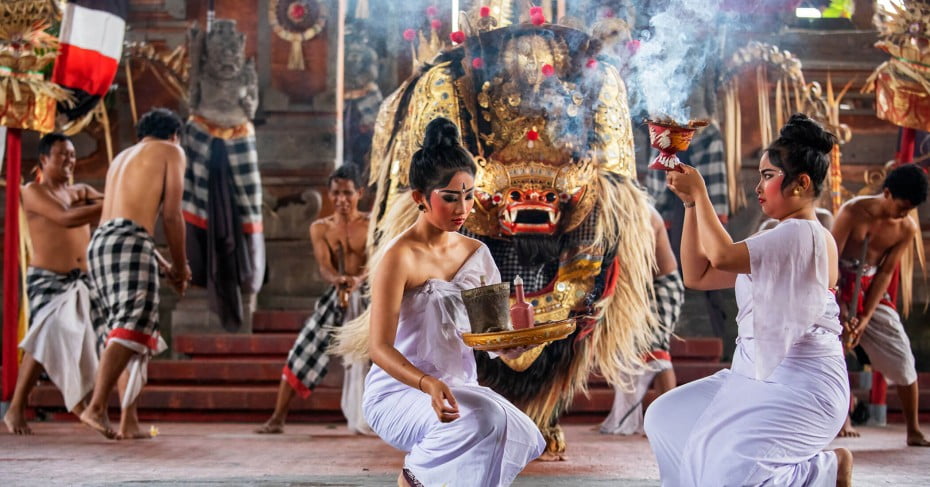By the Bronze era, around 300 B.C., a fairly evolved culture already existed on Bali. The complex system of irrigation and rice production, still in use today, was established around this time
It appears that the main religion around 500 A.D. was predominantly Buddhist in influence. In 670 A.D., a Chinese scholar (Yi-Tsing), on a trip to India, reported that he had visited a Buddhist country called Bali. It wasn’t until the 11th century that Bali received the first strong influx of Hindu and Javanese cultures. With the death of his father around AD 1011, the Balinese Prince, Airlanggha, moved to East Java and set about uniting it under one principality. Having succeeded, he then appointed his brother, Anak Wungsu, as ruler of Bali. During the ensuing period there was a reciprocation of political and artistic ideas. The old Javanese language, Kawi, became the language used by the aristocracy, one of the many Javanese traits and customs adopted by the people.
With the death of Airlanggha, in the middle of the 11th century, Bali enjoyed a period of autonomy. However, this proved to be short-lived, as in 1284 the East Javanese King Kertanegara, conquered Bali and ruled over it from Java. In 1292, Kertanegara was murdered and Bali took the opportunity to liberate itself once again. However, in 1343, Bali was brought back under Javanese control by its defeat at the hands of Gajah Mada, a general in the last of the great Hindu-Javanese empires, the Majapahit. With the spread of Islam throughout Sumatra and Java during the 16th century, the Majapahit empire began to collapse and a large exodus of aristocracy, priests, artists and artisans to Bali ensued. For a while Bali flourished and the following centuries were considered the Golden Age of Bali’s cultural history. The principality of Gelgel, near Klungkung, became a major centre for the arts, and Bali became the major power of the region, taking control of neighbouring Lombok and parts of East Java.
The European Influence
The first Dutch seamen set foot on Bali in 1597, yet it wasn’t until the 1800’s that the Dutch showed an interest in colonising the island. In 1846, having had large areas of Indonesia under their control since the 1700’s, the Dutch government sent troops into northern Bali. In 1894, Dutch forces sided with the Sasak people of Lombok to defeat their Balinese rulers. By 1911, all the Balinese principalities had either been defeated in battle, or had capitulated, leaving the whole island under Dutch control. During World War II, the Dutch were expelled by the Japanese, who had occupied Indonesia from 1942 to 1945.
After the Japanese defeat, the Dutch tried to regain control over their former colonies, but on August 17, 1945, Indonesia was declared independent by its first President, Sukarno. After four years of fighting and strong criticism from the international community, the Dutch government finally ceded and, in 1949, Indonesia was recognized as an independent country.
The People
Life in Bali is very communal with the organisation of villages, farming and even the creative arts being decided by the community. The local government is responsible for schools, clinics, hospitals and roads, but all other aspects of life are placed in the hands of two traditional committees, whose roots in Balinese culture stretch back centuries. The first, Subak, concerns the production of rice and organises the complex irrigation system. Everyone who owns a sawah, or padi field, must join their local Subak, which ensures that every member gets his fair share of irrigation water. The other community organisation is the Banjar, responsible for arranging all village festivals, marriage ceremonies and cremations. Most villages have at least one Banjar and all men have to join when they marry. Banjars, on average, give membership to 50 up to 100 families and all Banjars have their own meeting place called the Bale Banjar. As well as being used for regular meetings, the Bale (pavilion) is where the local gamelan orchestras and drama groups practice.
Religion
Balinese people are Hindu, yet their religion is very different from the Indian variety. The Balinese worship the Hindu trinity Brahma, Shiva and Vishnu, who are seen as manifestations of the Supreme God Sanghyang Widhi. Other Indian gods like Ganesha (the elephant-headed god) also appear, but more commonly. Shrines associated with the many gods and spirits, uniquely Balinese, are found all over the island. Balinese people strongly believe in magic and the power of spirits, basing much of their religion on this. They believe good spirits dwell in the mountains and that the seven seas are home to demons and ogres. Most villages have at least three main temples, namely: (1) the Pura Puseh, or ‘temple of origin’, facing the mountains; (2) the Pura Desa, or village temple normally found in the centre; and (3) the Pura Dalem, aligned with the sea and dedicated to the spirits of the dead. Aside from these ‘village temples’, almost every house has its own shrine. Some temples, for example Pura Besakih on the slopes of Mount Agung, are considerably more important and people from all over Bali travel there to worship.
Offerings play a significant role in Balinese life as they appease the spirits and thus bring prosperity and good health to the family. Every day small offering trays (canang sari), containing symbolic food, flowers, cigarettes and money, are respectfully put on shrines, in temples, in front of houses and shops, and at dangerous crossroads.
Festivals are another great occasion for soothing the gods. The women carry huge, beautifully arranged pyramids of food, fruit and flowers on their heads while the men might conduct a blood sacrifice through a cockfight. The gods are invited to descend and join the festivities with music and traditional dances to go with it. This kind of event is extremely exciting, memorable and well worth attending.
Please refer to the back page (‘A Word of Advice’) for Rules.


